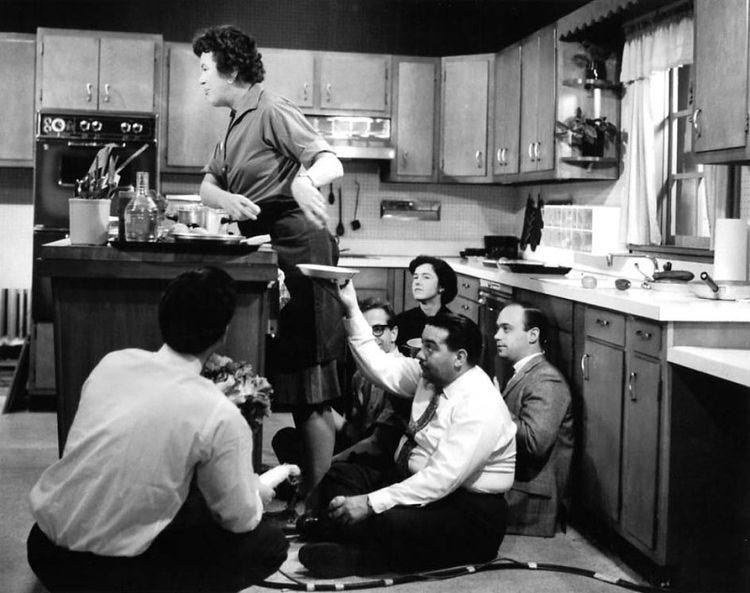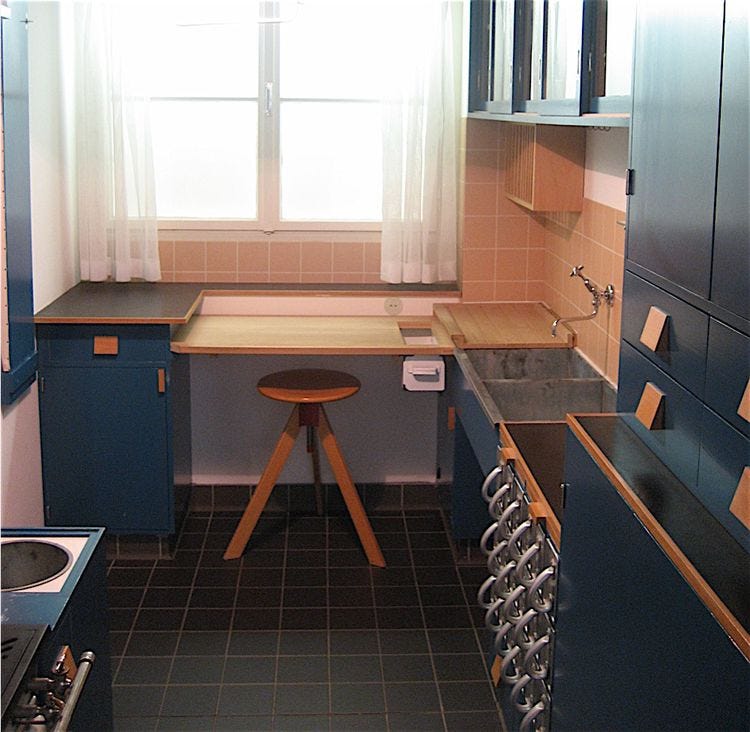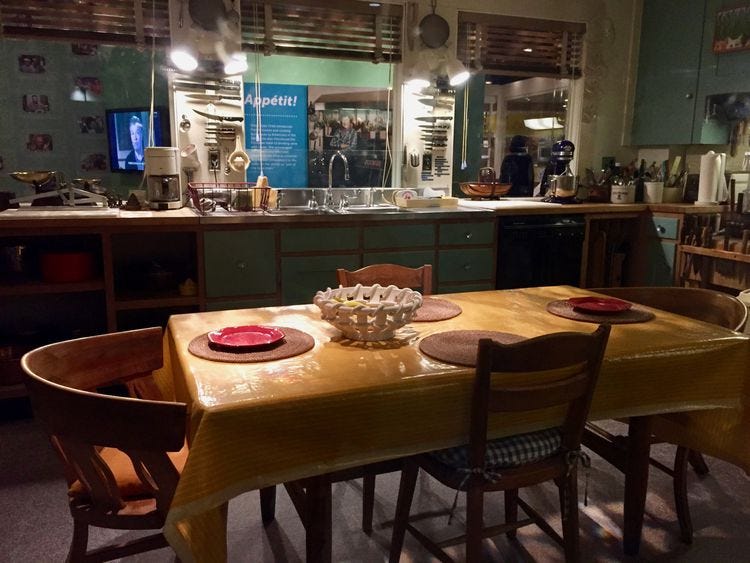Don't say goodbye to the kitchen (or dining) table
Don't listen to the designers; the kitchen island is no replacement for sitting down at a proper table.
When I was young, I loved to lie on the living room floor and look at my mom’s interior design and architecture magazines, including Better Homes and Gardens (BHG). I was thrilled when Dotdash, the company that owned my previous employer, Treehugger, bought Meredith, which owned BHG- I hoped there would be many opportunities to work together. Alas, Dotdash bit off more than it could chew; cutbacks and layoffs came shortly thereafter. That’s why I’m writing a Substack now, but I still look at BHG.
At year-end, Christianna Silva of BHG looked at trends and asked Is 2024 was the year we said goodbye to the kitchen table and say hello to the kitchen island as a multifunction replacement. They quote the National Kitchen and Bath Association’s annual trend report:
“As homes downsize, about half of designers say clients are opening their floor plans to feature eat-in kitchens with a maximized island rather than closed-off, formal dining rooms. While 57 percent of respondents prefer an eat-in kitchen, about 20 percent identified the use of traditional stand-alone kitchen tables as an outgoing trend—making room for a multifunction island. In addition to being used as a gathering place, work surface and dining table.”
There are fundamental issues and problems with this, the most important being safety. Nobody wants 4-year-olds perching on those barstool chairs, and older people hate them too; a restaurant in our neighbourhood opened with all high tables and chairs and had to replace them all; the older customers refused to sit at them. BHG continues:
The traditional dining table is so often associated with formal family dinners; it may be time for the island's more casual and interactive nature to take a turn.
Yes, eating is more casual, and formal dinners are disappearing, but nobody is interacting. Instead, people are snacking all day. A recent study found that “snacks accounted for 19.5% to 22.4% of people’s energy intake every day.” It’s led to an obesity crisis and a diabetes crisis, but some would also say it’s led to other problems within our families. Our kitchens are now being designed around snacking and constantly sipping; the NKBA notes:
“According to nearly 60 percent of this year’s survey respondents, a dedicated beverage area within the kitchen will be in demand. Whether for wine, smoothies or coffee, designers said homeowners are choosing more drink-focused storage, with 43.8 percent of respondents including refrigeration drawers in their kitchens and 44.2 percent of pantries incorporating bottle- and can-specific storage.”
So we’re snacking and sipping and according to another study, we are not even eating together in the same place or time.
While 72% of respondents said they grew up eating at the dining room table, only 48% do so today. Additionally, the couch has nearly tripled as the primary eating place (from 12% to 30%), along with the bedroom (6% to 17%).
I blame Julia Child for the kitchen island. Her show changed everything; she turned cooking into a performance and did it from behind an island, which is necessary in cooking shows so that the cook can look at the audience and the helpers can hide behind it. Marlen Komar wrote for The Kitchn, "Watching Julia add her sticks of butter while standing at her island on TV changed people’s perceptions of the counter space into a spot where you could hone your culinary skills, have fun experimenting with new recipes, and wow your guests with fancy appetizers."
Komar romanticizes the kitchen island:
“It’s where you chop tomatoes and talk about your day as your partner checks on what’s simmering on the stove, where your kid tells you how their spelling test went as they work through their pasta, where your guests mill about and eat prosciutto and green olives as you keep an eye on the first course baking in the oven, and where you uncork the wine and whip up cocktails as people mingle about.”
Except that’s not what’s happening. We are snacking and sipping and the island is covered with knapsacks and computers and nobody is talking about their day; they are looking at their phones.
BHG also gets romantic about the kitchen island.
“In contemporary homes, the kitchen is no longer a secluded space reserved for cooking—it's become a social hub for families and friends to gather. The multifunctional island supports this transition by providing a space for dining, informal conversations, homework sessions, and even remote work.”
Seriously, there is still a pandemic. You don’t want all this stuff happening in one place. You should be able to clean a counter without having to move all the computers and the homework.
This is why in Europe, in the 1930s, Austrian architect Margarete Schütte-Lihotzky was designing small, efficient, separate kitchens so you didn't have Pa, the pipe, and the newspaper all over the kitchen table. This is what people were trying to get away from.
When the hygiene movement took root after the First World War, it was thought that kitchens should be more like hospital rooms than living spaces. You don't want these people hanging around where all the food is, leaving their stuff all over the counters and touching everything. As Paul Overy wrote in Light, Air and Openness,
“Rather than the social centre of the house as it had been in the past, this was designed as a functional space where certain actions vital to the health and wellbeing of the household were performed as quickly and efficiently as possible.”
Overy quotes another architect of the period:
“Our apartment kitchens are arranged in a way which completely separates kitchen work from the living area, therefore eliminating the unpleasant effects produced by smell, vapours and above all the psychological effects of seeing leftovers, plates, bowls, washing-up clothes and other items lying around.”
Eighty years after that was written, leftovers and dirty dishes are still a problem. Readers often send me this image and write, “You see! Everyone wants to be in the kitchen!” The authors of the book it’s in tracked a family every 12 minutes throughout the day, and yes, they were all hanging out in the kitchen. But in interviews, they found:
“Parents’ comments on these spaces reflect a tension between culturally situated notions of the tidy home and the demands of daily life. The photographs reflect sinks at various points of the typical weekday, but for most families, the tasks of washing, drying, and putting away dishes are never done. ... Empty sinks are rare, as are spotless and immaculately organized kitchens. All of this, of course, is a source of anxiety. Images of the tidy home are intricately linked to notions of middle-class success as well as family happiness, and unwashed dishes in and around the sink are not congruent with these images.”
It’s also a lousy place to work or read. Critic Kate Wagner called for separate rooms in Citylab before the pandemic, originally titled “Death to the open floor plan”
“Not separating cooking, living, and dining is also an acoustical nightmare, especially in today’s style of interior design, which avoids carpet, curtains, and other soft goods that absorb sound. This is especially true of homes that do not have separate formal living and dining spaces but one single continuous space. Nothing is more maddening than trying to read or watch television in the tall-ceilinged living room with someone banging pots and pans or using the food processor 10 feet away in the open kitchen.”
Covid 19 is still in the air. People are doing more work from home. One would think that the last thing people would want is to spend all their time around the kitchen island! You should be able to separate work from cooking, and if you didn’t have a monster island, there might be room for both.
And don’t get me started on kitchen islands with gas stoves on them. That’s a whole other post about poisons.
There are other good reasons to rethink the way we eat and live today, and to bring back the family dinner around the table. Some, like Melinda Fakuade of Vox believe that the phone has become our new family connector and has killed dinner:
“Dinnertime is broader now — what time should we eat, in between working and commuting and practicing and studying and all our other -ings? It used to be that it was considered rude to phone someone during dinner, which loosely meant between six and seven at night. Now, it isn’t all that strange to watch adults and children alike text through their shared dinners, if they even salvage enough time and effort to share them at all.”
Indeed, I see this at our dining room table when the whole family is together- my two grown kids looking at their phones. It’s not quite as bad as the New Yorker’s Thanksgiving cover, but it’s a problem, and they are too old for me to criticize, especially if I want them to come again. This is why I am so impressed with my fellow former Treehugger and now Substacker Katherine Martinko. She wrote in a recent post,
“Family dinner is nonnegotiable in our household. It happens every single day, unless something major comes up. We avoid scheduling extracurricular activities that could interfere with it, and if they do, we shift dinner to happen before or after. There are no devices allowed at the table (obviously). Usually, we turn off whatever music we were listening to while cooking so that we can talk undistracted.”
BHG suggests that “The island's open design encourages free-flowing conversation between whoever's preparing the meal and whoever's enjoying it, fostering a sense of togetherness for the chef and diners.” Sounds more like a diner or snack bar to me, and Katherine has something to say about it:
When we all finally sit down together, no one is supposed to start eating until every plate has been filled. I’ve explained to my kids that this shows respect for the cook, who has worked so hard to prepare the food and deserves to eat at the same time as everyone else. (At least, that’s how I feel, as the primary cook!)
As much as I believe we should cry death to the open kitchen, it’s true that many people don’t have room for a separate formal dining room. But even Julia Child didn’t have her kitchen island at home; she had a big kitchen table where she could sit comfortably on normal chairs. Sorry, Emily and the gang at BHG; 2024 should be the year we kill the island and bring back the kitchen or dining room table and the family dinner.











The article and comments seem to point to one conclusion: there is no one-size-fits-all solution. Each individual and each family will have their habits and their preferences. We have a couple of stools at our peninsula, and these were absolute life-savers during the years when my children needed to be with me almost all the time. How many meals did I prepare while my girls did crafts or "helped" me with dinner prep? We now like to eat at the peninsula on busy weekday mornings, and sometimes for dinner when I'm solo parenting for the evening and we have a short window of time before taking one or both teens to an evening lesson or activity. Most other meals are consumed in the dining room, which is just a few steps away through a wide opening. The real enemy, it seems to me, is technology at the table (any table): it signals our divided attention, and usually spells the end to meaningful interactions or good conversation during a meal.
Enjoyed this piece! My family has a closed dining room and we do spend a ton of time there, but I think that is largely due to the fact that I have young kids and the dining room table serves as also their art center/doodle pad/etc. I will say that I don't love having the separation between kitchen and dining room and have often fantasized about renovating to open it up! But I go back and forth for some of the reasons mentioned in your piece. When the kids were younger, it was impossible to cook and keep an eye on them at the same time. Now they sort of feel ignored when I'm in the kitchen cooking and they're in the dining room -- there's a lot of yelling across walls because there's nowhere to sit in the kitchen so I do see the appeal of those barstools! I do think that if you want to have a "proper" meal with family, it's less about design and more about making an effort. Every Friday night we make the effort (this can be a Shabbat or a non-religious experience) and really enforce behavior standards, raise the bar on what we cook, etc. that we don't often do during the week. This feels much more achievable than trying to make every meal special and can be done no matter the design of the space.